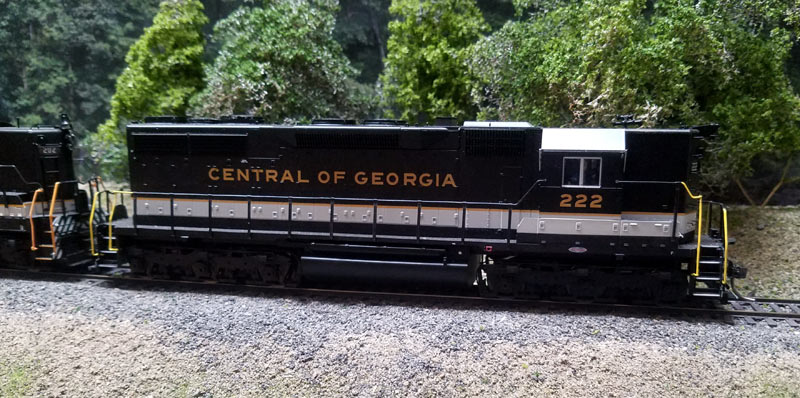The area around the roundhouse and turntable is about 85% finished. It is still lacking a lot of little details and figures but it is time to move on. As the mood strikes me, I will add details as I go forward a little bit at time.
Just to left, or west, of the roundhouse is the "new" diesel servicing and shop facility. The two structures were kit bashed while I was recovering from my first knee replacement. Three kits from Pikestuff make up the complex. The pad is styrene concrete and the stalls have pits modified for use with code 70 rail. The complex, built at my desk, sits on its own base. The toggle switches along the fascia are on/off switches various sections of track within the complex (The noise from 7-10 sound equipped locomotives can be a bit much).
The three Southern units are sitting on the inspection track. The stores department is located behind, to the left, of the covered pit. Two tracks run into the shop building with one track extending all the way through the building and out the far side. The inspections/stores building and shop are separated by a office/admin building. The fuel and sand tracks will be in the left foreground where the narrow pad of concrete extends off to the left. Two tracks run into the shop; one extends all the way through the building. The Preston Miller Yard lead runs behind the shop building.
Ballast for the engine facility and yard is a mix of 2 parts Highball cinders, 1 part Arizona Rock GN/SP Gray and 1 part Arizona Yard Mix Still some work to be done including servicing details, figures, etc. ground cover and some static grass but the scene is approaching the 80% point that will allow to me to move on.
Operations - Developing a Freight Car Fleet
Alert... Before going any further, I want to warn you that I can't believe I went through all of this to come up with the information for some software data files or to fill out a couple of hundred 4 destination Micro Mark two sided waybills. If you are not interested, to the degree that I am in operations, you may want to skip down to the section on mixed train service.
Rolling Stock
And finally, since all of my cars are routed or received from off line points, a rolling stock interchange chart was created along with all the information needed to create the Caroute data files or the Micro Mark 4 destination waybill.
All of these charts were created with Excel so it is easy to go back into the spread sheet to add new cars or make changes.
Mixed Train Service
A post or two ago I mentioned the addition of mixed train service to the Madisonville Sub. To that end, I added a old AMM combine to the roster (still on my work desk undergoing modification) and a new Bachmann combine that I found left over from my store inventory. While I plan to add some grabs and weathering to the Bachmann combine in the near future, I decided to press it into service now on the Sparta mixed. The daily Sparta Mixed originates in Madisonville (staging) and runs through Bowling Green to Sparta (staging) and returns to Madisonville.
Led by Central of Georgia GP-7 #130, the short mixed is about to cross the Cumberland River near State Line.
A few miles south (railroad east) the old heavyweight combine has come to a rest in front of the small Westmoreland passenger shelter.
And finally, we catch the mixed passing by the company houses and MOW yard just outside Tunnel 2.























































